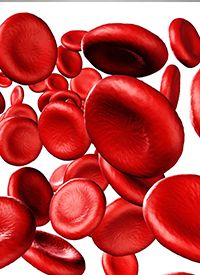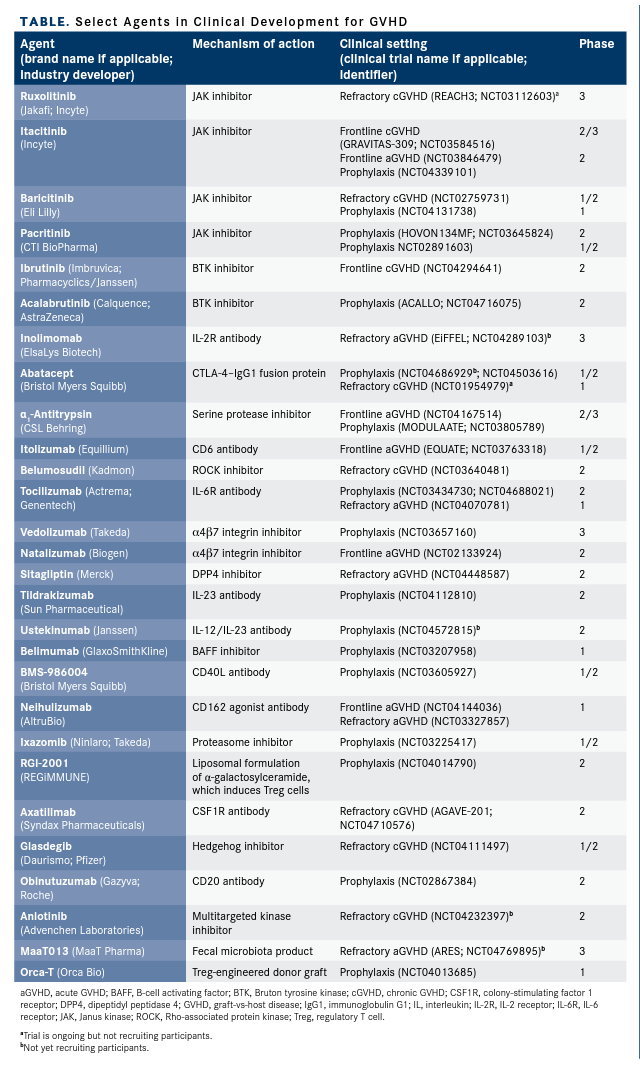Publication
Article
New Approaches Seek to Meet the Challenge of Graft-Vs-Host Disease
Author(s):
The curative potential of allogeneic hematopoietic stem cell transplantation for many hematologic malignancies is hindered by the frequent development of graft-vs-host disease, a potentially fatal complication resulting from a complex interaction between donor immune cells in the graft and the host’s immune system.

The curative potential of allogeneic hematopoietic stem cell transplantation (HSCT) for many hematologic malignancies is hindered by the frequent development of graft-vs-host disease (GVHD), a potentially fatal complication resulting from a complex interaction between donor immune cells in the graft and the host’s immune system.1,2
Identifying ways to effectively manage GVHD without losing the beneficial antitumor immune response generated by those same immune cells—the graft-vs-tumor effect—is the holy grail of the HSCT field.
A greater understanding of the complex pathophysiology underlying the development of GVHD has fostered the development of a host of potential new treatment options, particularly for disease that has become resistant to frontline therapy.1-3
In the past 4 years, the Bruton tyrosine kinase (BTK) inhibitor ibrutinib (Imbruvica) and the Janus kinase (JAK) inhibitor ruxolitinib (Jakafi) have made history as the first drugs approved for the treatment of steroid-refractory (SR) chronic GVHD (cGVHD) and acute GVHD (aGVHD), respectively.4,5
Now, investigators are exploring novel agents in prophylactic as well as refractory treatment settings (TABLE). A Rho-associated protein kinase (ROCK) inhibitor, belumosudil, and an interleukin 2 receptor (IL-2R)–targeted monoclonal antibody, inolimomab (Leukotac), lead the pack among drugs with diverse mechanisms of action that are currently in clinical development. Both are undergoing FDA review of biologics license applications.6,7
TABLE. Select Agents in Clinical Development for GVHD

A CHALLENGING COMPLICATION
There are 2 major types of GVHD. First is aGVHD, which occurs within the initial 100 days after allogeneic HSCT and manifests primarily in the skin, gastrointestinal tract, and liver. Second is cGVHD, which is seen beyond day 100 post HSCT; it can arise independently of or following aGVHD and can affect any organ within the body. The lines between the 2 types often blur; late aGVHD can occur more than 100 days post HSCT, and an overlap syndrome exists that involves both the acute and chronic forms.1,2,8
The incidence of GVHD varies widely depending on a number of risk factors, including the strength of donor match, donor and recipient age, donor-recipient sex match, source of stem cells, and type of conditioning regimen.1,3,8 Prior development of aGVHD is a significant risk factor for subsequent cGVHD.8 Rates can exceed 70% in certain situations.9
GVHD is a major driver of postHSCT morbidity and mortality1,10; only 25% to 30% of patients who experience grade 3 aGVHD survive for more than 2 years, and survival plummets to only 1% to 2% in those with grade 4 aGVHD.1
No standard management regimen exists for GVHD, and clinical practice varies widely, but prevention and treatment are centered around immune suppression and depletion of cytotoxic T cells. Prevention of aGVHD most commonly involves an immunosuppressive calcineurin inhibitor (cyclosporine or tacrolimus) paired with methotrexate, an antimetabolite that suppresses T-cell proliferation. Agents commonly used to prevent cGVHD include antithymocyte globulin (ATG) and high- dose cyclophosphamide.3
Clinically significant GVHD occurs frequently in spite of prophylaxis, and corticosteroids are the mainstay of frontline therapy. Unfortunately, these drugs can have significant adverse effects; fewer than half of patients with grade 2 to 4 aGVHD respond, and outcomes are dismal in patients with SR disease, who historically have had limited treatment options.1,3
PROINFLAMMATORY CYTOKINES
In recent years, investigators have turned to targeted therapies in a search for better GVHD treatments. Proinflammatory cytokines are major effectors of GVHD pathogenesis, and drugs blocking their activity have been a major focus of clinical development.11 Some cytokine inhibitors have shown promise, and a few that are approved for other indications, such as the tumor necrosis factor αtargeting antibodies infliximab (Remicade) and etanercept (Enbrel), are used off label.9,12
Inolimomab is a monoclonal antibody targeting IL-2R. IL-2, a proinflammatory cytokine produced by activated helper T cells, binds to the IL-2R present on the surface of activated cytotoxic T cells and triggers production of other proinflammatory cytokines. Theoretically, inolimomab should disrupt this process.2,13
In July 2020, ElsaLys Biotech submitted a biologics license application for inolimomab for the treatment of SR aGVHD, according to a company news release.7 Data from a phase 3 study (EudraCT 2007-005009-24) in which inolimomab was compared with ATG, a drug that is often used off label for the treatment of SR aGVHD, are being used to support approval.14
In an initial analysis published in 2017, the primary end point of the trial was not met; there was no significant difference in overall survival (OS) at 1 year between inoli-momab (28.5%) and ATG (21.5%) (HR, 0.874; P = .28).15 However, a trend toward improved OS was borne out with longer-term follow-up. At a median follow-up of 58.4 months, 30.6% of inolimomab-treated patients were alive, compared with 19.6% of patients in the ATG arm (HR, 0.572; 95% CI, 0.346-0.947; P = .030). The 2 drugs had comparable safety profiles but, notably, fewer viral infections occurred with inolimomab.14,15
DOWNSTREAM EFFECTORS
Investigators have also turned to the intra-cellular signaling pathways that mediate the downstream effects of proinflammatory cytokines, such as the JAK/STAT pathway.16 These efforts yielded the first FDA-approved drug for the treatment of SR aGVHD in adult and pediatric patients 12 years and older in 2019.4 In the phase 2 REACH1 study (NCT02953678), undertaken in patients who had been previously treated with a maxi-mum of 1 systemic therapy in addition to corticosteroids, ruxolitinib in combina-tion with corticosteroids demonstrated a day-28 overall response rate (ORR) of 54.9% and a 6-month OS rate of 73.2% among 28-day responders.17
In the confirmatory phase 3 REACH2 trial (NCT02913261), ruxolitinib elicited a day-28 ORR of 62% compared with 39% for best available therapy (BAT; odds ratio [OR], 2.64; 95% CI, 1.65-4.22; P < .001). Day-56 ORR was also better in the ruxolitinib group (40% vs 22%; OR, 2.38; 95% CI, 1.43-3.94; P < .001).18 Ongoing clinical studies include the phase 3 REACH3 trial (NCT03112603), in which ruxolitinib is being compared with BAT in SR cGVHD in patients 12 years and older. In primary results presented at the 62nd American Society of Hematology Annual Meeting & Exposition, ruxolitinib demon-strated an ORR of 49.7% vs 25.6% with BAT at week 24 (OR, 2.99; 95% CI, 0.86-4.80; P < .0001). The FDA has granted a priority review for a new indication for ruxolitinib in SR cGVHD, with a June 22, 2021, deadline for making a decision, according to Incyte, the drug’s developer.19,20
Itacitinib is a more selective JAK inhibitor than ruxolitinib and is thought to have less hematologic toxicity as a result.2,3 The phase 3 GRAVITAS-301 trial (NCT03139604), which evaluated itacitinib in combination with corticosteroids for frontline treatment of aGVHD, failed to meet its primary end point.21 Clinical trials of itacitinib and 2 other JAK inhibitors, baricitinib and pacritinib, are ongoing in several GVHD settings.
ROCK is another downstream kinase under investigation. The ROCK protein has 2 isoforms—ROCK1 and ROCK2—and Rho-ROCK signaling is best known for its role in regulation of the actin cytoskeleton; however, ROCK2 has also been shown to regulate the production of proinflammatory cytokines.22,23
Belumosudil is a selective ROCK2 inhibitor, and promising results from the phase 2 ROCKstar trial (NCT03640481) in patients with SR cGVHD were recently announced by Kadmon, the drug’s developer. Belumosudil elicited ORRs in excess of 70% at a 200-mg dose on both once- and twice-daily schedules. On the basis of these results, a new drug application was submitted to the FDA; a decision is expected by August 30, 2021.6,24
MANIPULATING T CELLS
Blocking the effects of proinflammatory cytokines indirectly tempers activation of T cells, the central players of GVHD, but mechanisms to more directly impact T-cell activation have also been explored, including the use of drugs designed to inhibit T-cell costimulation.
Abatacept (Orencia), which is FDA approved for several forms of arthritis, is a fusion protein consisting of the extracellular domain of the coinhibitory protein CTLA-4 and part of the Fc domain of immunoglobulin G1; abatacept binds the CD80/CD86 ligands on antigen-presenting cells and prevents them from engaging the costimulatory receptor CD28.25 The agent was recently granted a breakthrough therapy designation by the FDA for prevention of aGVHD, based on data from the phase 2 ABA2 trial (NCT01743131), in which it reduced the incidence of aGVHD and improved severeGVHD–free survival when added to a standard prophylactic regimen.26,27
Itolizumab, which is approved in India under the brand name Alzumab, targets CD6, a T-cell costimulatory receptor,2 and it has been granted fast track and orphan drug designations by the FDA for treatment of patients with aGVHD.28 It is currently being evaluated,in combination with corticosteroids, as frontline treatment for severe (grade 3-4) aGVHD in the phase 1/2 EQUATE trial (NCT03763318). Promising safety and efficacy data from the first 2 cohorts of this study were recently announced.29
The manipulation of donor T-cells extends beyond activating them; for example, the migration of the T cells to sites of inflammation may be blocked. The α4β7 integrin receptor is found on the surface of cytotoxic T cells and is involved in their trafficking to sites of intestinal inflammation.3
Vedolizumab (Entyvio) is an α4β7 integrin–binding antibody that has been studied as a treatment for SR aGVHD. Findings from several case series have reported mixed results for vedolizumab in this setting, and a prospective phase 2 study (NCT02993783) was recently terminated early due to lack of efficacy.1,30 The focus of vedolizumab development has now shifted to the prevention of aGVHD,1 and data from a phase 1b study (NCT02728895) were recently published.
In that trial, 21 patients were treated with 300 mg vedolizumab administered intravenously 1 day before and 13 and 42 days after allogeneic HSCT, in combination with tacrolimus and methotrexate. Only 4 patients developed grade 2 to 4 aGVHD by day 100.31 These data support an ongoing phase 3 trial of vedolizumab in the prevention of intestinal aGVHD (NCT03657160).
Natalizumab (Tysabri), also an α4β7 integrin–binding antibody, is being studied in combination with corticosteroids as a frontline treatment option for aGVHD. Results from a phase 2 study (NCT02176031) were recently published; the day-56 GVHDfree survival rate was 33.3%, day-56 ORR was 52%, 2-year OS was 43%, and 2-year nonrelapse mortality was 52%.32
Efforts are also underway to target aberrantly activated B cells, given their importance in the development of cGVHD. Ibrutinib targets the BTK protein, which mediates intracellular signaling downstream of the B-cell receptor to regulate B-cell activation. Thus, by inhibiting BTK, ibrutinib blocks B-cell activation.8,33
Ibrutinib was approved in 2017 for the treatment of SR cGVHD after the failure of 1 or more lines of systemic therapy in 2017. The approval was based on the results of a phase 1/2 study (NCT02195869) in which ibrutinib demonstrated an ORR of 67%, with 71% of responders showing a sustained response (20 weeks or more).34 A phase 2 trial (NCT04294641) of ibrutinib for frontline treatment of cGVHD is ongoing, and another BTK inhibitor, acalabrutinib (Calquence), is being investigated for its potential to prevent cGVHD in the ongoing ACALLO trial (NCT04716075).
ADDING TREGs
Investigators also are exploring whether the addition of enriched regulatory T cells (Tregs) to the HSCT treatment regimen can reduce or prevent GVHD. Orca-T is an allogeneic cell therapy engineered from donor-derived, high-purity Tregs; findings were presented during the 2021 Transplantation & Cellular Therapy Meetings.35
Results were presented for patients with hematologic malignancies who were undergoing myeloablative conditioning; they received CD34-selected cells infused with highly purified Tregs followed by the adoptive transfer of conventional T cells in a single-center phase 1/2 study (NCT01660607) and a multicenter phase 1b study (NCT04013685).
Among 34 patients who received Orca-T plus GVHD prophylaxis with either tacrolimus or sirolimus during the studies, the incidence of grade 2 or greater aGVHD was 10% and the rate of cGVHD was 3%. These results compared favorably with the GVHD incidence of 30% and 46%, respectively, in a matched cohort of transplant recipients treated with standard-of-care therapy at Stanford University in California, which is pioneering Orca-T. Additionally, the incidence of treatment-related mortality was 0% with Orca-T vs 11% with standard of care.35
The results show that Orca-T therapy can be successfully manufactured and administered in a multicenter environment, investigators concluded.
References
- Malard F, Huang X-J, Sim JPY. Treatment and unmet needs in steroid-refractory acute graft-versus-host disease. Leukemia. 2020;34(5):1229-1240. doi:10.1038/s41375-020-0804-2
- Kasikis S, Etra A, Levine JE. Current and emerging targeted therapies for acute graft-versus-host disease. BioDrugs. 2021;35(1):19-33. doi:10.1007/s40259-020-00454-7
- DiMaggio E. Acute graft-versus-host disease: emerging insights and updates into detection, prevention, and treatment. Pharmacotherapy. 2020;40(8):788-807. doi:10.1002/phar.2436
- Przepiorka D, Luo L, Subramaniam S, et al. FDA approval summary: ruxolitinib for treatment of steroid‐refractory acute graft‐versus‐host disease. Oncologist. 2020;25(2):e328-e334. doi:10.1634/theoncologist.2019-0627
- FDA expands ibrutinib indications to chronic GVHD. FDA. August 2, 2017. Accessed March 1, 2021. https://www.fda.gov/drugs/resources-information-approved-drugs/fda-expands-ibrutinib-indications-chronic-gvhd
- Kadmon announces U.S. FDA has extended the review period for belumosudil in chronic graft-versus-host disease. News release. Kadmon Holdings, Inc; March 10, 2021. Accessed March 30, 2021. https://investors.kadmon.com/news-releases/news-release-details/kadmon-announces-us-fda-has-extended-review-period-belumosudil
- ElsaLys Biotech announces submission of biologics license application to FDA for Leukotac (inolimomab) for the treatment of graft-versus-host disease in adult patients. News release. ElsaLys Biotech; July 23, 2020. Accessed February 26, 2021. https://www.elsalysbiotech.com/node/113
- Zeiser R, Blazar BR. Pathophysiology of chronic graft-versus-host disease and therapeutic targets. N Engl J Med. 2017;377(26):2565-2579. doi:10.1056/NEJMra1703472
- Mandanas RA, Yuen C. Graft versus host disease. Medscape. Updated January 27, 2020. Accessed March 2, 2021. https://emedicine.medscape.com/article/429037-overview
- MacDonald KPA, Hill GR, Blazar BR. Chronic graft-versus-host disease: biological insights from preclinical and clinical studies. Blood. 2017;129(1):13-21. doi:10.1182/blood-2016-06-686618
- Kumar S, Mohammadpour H, Cao X. Targeting cytokines in GVHD therapy. J Immunol Res Ther. 2017;2(1):90-99.
- Elbendary A, Kellen R. Off-label uses of biologic agents approved for psoriasis and psoriatic arthritis for dermatological conditions: part II. J Psoriasis Psoriatic Arthr. 2017;2(2):65-72. doi:10.1177/247553031700200205
- Petrolini Capobianco M, Capatti Cassiano G, da Cruz Furini AA, Moreno Storti de Melo L, Bonini Domingos CR, Dantas Machado RL. Human interleukin 2 (IL-2) promotion of immune regulation and clinical outcomes: a review. J Cytokine Biol. 2016;1:109. doi:10.4172/jcb.1000109
- Socié G, Milpied N, Yakoub-Agha I, et al. Long-term follow-up of a phase 3 clinical trial of inolimomab for the treatment of primary steroid refractory aGVHD. Blood Adv. 2019;3(2):184-186. doi:10.1182/bloodadvances.2018028282
- Socié G, Vigouroux S, Yakoub-Agha I, et al. A phase 3 randomized trial comparing inolimomab vs usual care in steroid-resistant acute GVHD. Blood. 2017;129(5):643-649. doi:10.1182/blood-2016-09-738625
- Schwartz DM, Kanno Y, Villarino A, Ward M, Gadina M, O’Shea JJ. JAK inhibition as a therapeutic strategy for immune and inflammatory diseases. Nat Rev Drug Discov. 2017;17(1):78. doi:10.1038/nrd.2017.267
- Jagasia M, Perales M-A, Schroeder MA, et al. Ruxolitinib for the treatment of steroid-refractory acute GVHD (REACH1): a multicenter, open-label phase 2 trial. Blood. 2020;135(20):1739-1749. doi:10.1182/blood.2020004823
- Zeiser R, von Bubnoff N, Butler J, et al; REACH2 Trial Group. Ruxolitinib for glucocorticoid-refractory acute graft-versus-host disease. N Engl J Med. 2020;382(19):1800-1810. doi:10.1056/NEJMoa1917635
- Zeiser R, Polverelli N, Ram R, et al. Ruxolitinib (RUX) vs best available therapy (BAT) in patients with steroid-refractory/steroid-dependent chronic graft-vs-host disease (cGVHD): primary findings from the phase 3, randomized REACH3 study. Blood. 2020;136(Suppl 1):22-24. doi:10.1182/blood-2020-137694
- Incyte announces acceptance and priority review of sNDA for Jakafi (ruxolitinib) as a treatment for patients with chronic graft-versus-host disease. News release. Incyte; February 22, 2021. Accessed March 31, 2021. https://bwnews.pr/2OfIXgI
- Zeiser R, Socié G, Schroeder MA, et al. Gravitas-301: a randomized, double-blind phase 3 study of itacitinib or placebo in combination with corticosteroids for initial treatment of patients with acute graft-versus-host disease. Presented at: 25th Annual Congress of the European Hematology Association; June 11-21, 2020; virtual. Abstract S256. Accessed March 3, 2021. https://bit.ly/3rhr0MT
- Clayton NS, Ridley AJ. Targeting Rho GTPase signaling networks in cancer. Front Cell Dev Biol. 2020;8:222. doi:10.3389/fcell.2020.00222
- Hill L, Alousi A, Kebriaei P, Mehta R, Rezvani K, Shpall E. New and emerging therapies for acute and chronic graft versus host disease. Ther Adv Hematol. 2018;9(1):21-46. doi:10.1177/2040620717741860
- Kadmon announces positive topline results of pivotal trial of belumosudil (KD025) in chronic graft-versus-host disease. News release. Kadmon Holdings, Inc; May 21, 2020. Accessed March 2, 2021. https://investors.kadmon.com/news-releases/news-release-details/kadmon-announces-positive-topline-results-pivotal-trial/
- Buch MH, Vital EM, Emery P. Abatacept in the treatment of rheumatoid arthritis. Arthr Res Ther. 2008;10 Suppl 1(Suppl 1):S5. doi:10.1186/ar2416
- Watkins B, Qayed M, McCracken C, et al. Phase II trial of costimulation blockade with abatacept for prevention of acute GVHD. J Clin Oncol. Published online January 15, 2021. doi:10.1200/JCO.20.01086
- Bristol-Myers Squibb announces U.S. FDA breakthrough therapy designation for Orencia (abatacept) to help prevent acute graft [-versus-host disease]. News release. Bristol-Myers Squibb; December 4, 2019. Accessed March 1, 2021. https://news.bms.com/news/details/2019/Bristol-Myers-Squibb-Announces-US-FDA-Breakthrough-Therapy-Designation-for-ORENCIA-abatacept-to-Help-Prevent-Acute-Graft/default.aspx
- Pipeline. Equillium Bio. Accessed February 25, 2021. https://equilliumbio.com/pipeline/
- Equillium announces positive interim data with itolizumab in acute GVHD study. News release. Equillium, Inc; August 10, 2020. Accessed February 25, 2021. http://www.globenewswire.com/news-release/2020/08/10/2075965/0/en/Equillium-Announces-Positive-Interim-Data-with-Itolizumab-in-Acute-GVHD-Study.html
- A dose-finding study of vedolizumab for treatment of steroid-refractory acute intestinal graft-versus-host disease (GvHD) in patients who have undergone allogeneic hematopoietic stem cell transplantation (Allo-HSCT). ClinicalTrials.gov. Updated May 24, 2019. Accessed March 1, 2021. https://clinicaltrials.gov/ct2/show/NCT02993783
- Chen Y-B, Shah NN, Renteria AS, et al. Vedolizumab for prevention of graft-versus-host disease after allogeneic hematopoietic stem cell transplantation. Blood Adv. 2019;3(23):4136-4146. doi:10.1182/bloodadvances.2019000893
- Kekre N, Kim HT, Hofer J, et al. Phase II trial of natalizumab with corticosteroids as initial treatment of gastrointestinal acute graft-versus-host disease. Bone Marrow Transplant. Published online September 8, 2020. doi:10.1038/s41409-020-01049-0. Published correction appears in Bone Marrow Transplant. Published online October 12, 2020.
- Jaglowski SM, Blazar BR. How ibrutinib, a B-cell malignancy drug, became an FDA-approved second-line therapy for steroid-resistant chronic GVHD. Blood Adv. 2018;2(15):2012-2019. doi:10.1182/bloodadvances.2018013060
- Miklos D, Cutler CS, Arora M, et al. Ibrutinib for chronic graft-versus-host disease after failure of prior therapy. Blood. 2017;130(21):2243-2250. doi:10.1182/blood-2017-07-793786
- Meyer EH, Hoeg R, Moroz A, et al. Orca-T, a precision Treg-engineered donor product, in myeloproliferative HLA-matched transplantation prevents acute and chronic GVHD with less immunosuppression in an early multicenter experience. Presented at: 2021 Transplantation & Cellular Therapy Meetings; February 8-12, 2021; virtual. Abstract 88.










